
Cydia is a large genus of tortrix moths, belonging to the tribe Grapholitini of subfamily Olethreutinae. Its distinctness from and delimitation versus the tribe's type genus Grapholita requires further study.

Cochylis nana is a moth of the family Tortricidae. It was described by Adrian Hardy Haworth in 1811. It is found in Europe, Amur Oblast of Russia and Nova Scotia in Canada.

Archips xylosteana, the variegated golden tortrix or brown oak tortrix, is a moth of the family Tortricidae.

Enarmonia formosana, the cherrybark tortrix or cherry-bark moth, is a small but colorful moth species of the family Tortricidae. It is native to all of northern and western Europe, ranging south to the Maghreb. North of the Alps its range extends eastwards to Siberia and Kazakhstan. Possibly and most likely introduced populations are found in Asia Minor and North America, respectively.

Olethreutes arcuella, the arched marble, is a colorful small moth species of the family Tortricidae.
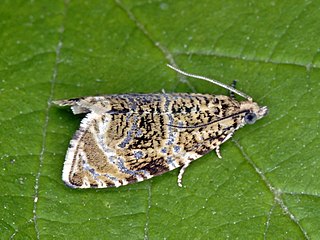
Syricoris lacunana, the dark strawberry tortrix, is a small moth species of the family Tortricidae. It is found in the Palearctic realm.

Celypha rufana, common name lakes marble, is a small moth species of the family Tortricidae, long known under the junior synonym C. rosaceana.
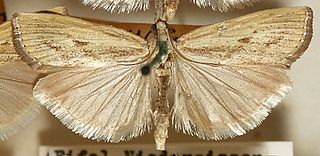
Agriphila inquinatella is a small moth species of the family Crambidae. It is found in Europe, around the Caucasus area to Turkestan, and in the Near East to Jordan. The type locality is in Austria.

Batia lunaris, the lesser tawny crescent, is a species of gelechioid moth. It belongs to the subfamily Oecophorinae of the concealer moth family (Oecophoridae). It is the type species of the genus Batia, which is sometimes treated as monotypic. But this is not well warranted, as some other species usually placed there differ little from the Lesser Tawny Crescent.

Nemapogon cloacella, the cork moth, is a species of tineoid moth. It belongs to the fungus moth family (Tineidae), and therein to the subfamily Nemapogoninae. Its junior synonym N. infimella was established by G.H. Heydenreich in the 1851 volume of his Lepidopterorum Europaeorum Catalogus Methodicus, but many sources still attribute it to G.A.W. Herrich-Schäffer, who supposedly narrowly beat Heidenreich in (re)describing the species. But as it seems, Herrich-Schäffer was merely one of the first to use the name proposed by Heydenreich, as the volume of his Systematische Bearbeitung der Schmetterlinge von Europa where he discussed the cork moth was not published until 1853 or 1854. That all nonwithstanding, the species had been already validly described by A.H. Haworth in the 1828 volume of Lepidoptera Britannica.

Alabonia geoffrella is a species of gelechioid moth. Here, it is placed within the subfamily Oecophorinae of the concealer moth family (Oecophoridae). Alternatively it has been placed in the Elachistidae or Depressariinae together with its presumed closest relatives.
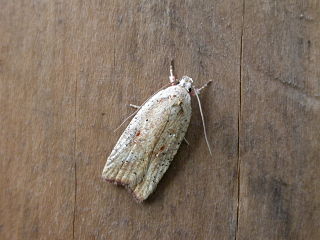
The gorse tip moth is a smallish moth species of the family Depressariidae.

Cnephasia asseclana, the flax tortrix, is a moth of the family Tortricidae. It is found all over Europe.
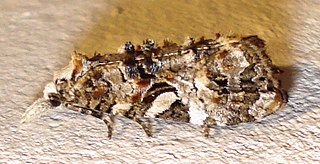
Phtheochroa rugosana is a small moth of the family Tortricidae.

Celypha is a genus of tortrix moths. It belongs to the tribe Olethreutini of subfamily Olethreutinae.
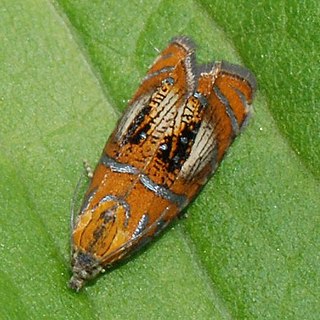
Olethreutes is a large genus of tortrix moths. It is the type genus of its tribe (Olethreutini) and subfamily (Olethreutinae).

Cnephasia is a genus of tortrix moths. It belongs to the subfamily Tortricinae and therein to the tribe Cnephasiini, of which it is the type genus.

Ditula angustiorana, the red-barred tortrix, is a moth of the family Tortricidae found in Africa, Asia, Europe and North Africa. Other common names are the fruit-tree tortrix and the vine tortrix. The moth was first described by Adrian Hardy Haworth in 1811.

Cydia duplicana is a small moth of the family Tortricidae. It is found in all across Europe, extending barely into Asia in the Transcaucasus, Turkestan and Kazakhstan.

Cydia illutana is a small moth of the family Tortricidae. It is found from western and central Europe, north to Scandinavia and east to Russia (Siberia).




















